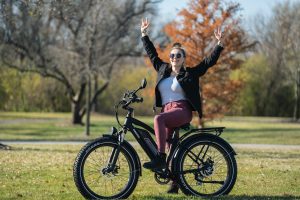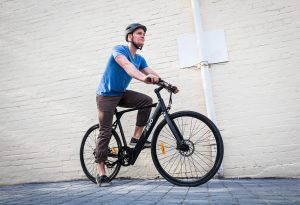
Let’s face it; twisting a throttle isn’t much work.
So, is an electric bike still good exercise, or are ebikes just a way to pretend to stay active?
The truth is that the amount of exercise you get depends on how you use your electric bike.
If you choose a lower pedal-assist setting, an eBike can provide nearly as much exercise as a conventional bike. We checked the numbers.
In my early teens, I rode my bike everywhere, and it was fantastic exercise. I scaled impossible hills, barreling down the other side. I tore through pricker-bush trails, splashed through creeks, and soared so high over jumps I could see my shadow follow in chase.
As kids, we had an (over)active lifestyle, burning hundreds of calories per hour, our fitness levels off the charts.
That was then; this is now. We all slow down. An eBike is a better fit for the (safer) way I ride now, and yes, it’s still good exercise.
Depending on the level of assistance levels you choose, an eBike can provide a moderate-intensity workout nearly on par with a regular bike.
But you’ll have to lay off the throttle.
The Secret is Frequency
I compare electric bikes to people-powered bikes in this post because that’s where many people are in the decision process. You might be weighing buying an eBike versus dusting off the normal bike sitting in your garage as a way to increase physical activity.
A regular bicycle gives you a better workout, without a doubt. It’s exclusively people-powered.
But that’s exactly the problem.
A standard bike requires work, so the tendency is not to ride as often. If you’ve ever seen an indoor exercise bike used as a clothes rack, you know what I mean.
Electric bikes still require some effort. But you’ll get assistance while you exercise, which makes pedaling a breeze instead of a chore. And hills, the single biggest reason that traditional bikes sit unused in garages, become smaller obstacles.
A well-chosen eBike flattens hills, allowing even out-of-practice riders to conquer gravity like a champ.
Ease of use leads to more frequent use.
You’ll find yourself choosing the electric bike instead of your car as a mode of transportation for local errands. You might even decide to commute to work on your eBike. And on a sunny day, you’ll saddle up for a ride without thinking twice as you might with a standard bike.
In short, an electric bike can help you get more active, boosting cardiovascular health, burning calories, and toning muscle almost as much as a traditional bicycle.
If you’ve ever pedaled a standard bike up a steep hill, you already know a non-assisted bike offers a better workout compared to an electric bike. But if the bike sits in the garage because hills are hard work, how much exercise are you really getting?
Electric Bikes for Exercise: Digging into the Numbers
Electric bikes can provide real-world health benefits if you’re willing to exercise some discipline. Hands off the throttle, riders. It’s time to pedal.
Does riding an electric bike help you lose weight? It can.
A recent study compared the metabolic and cardiovascular effects of standard bicycles versus electric bikes. The key finding of the study was that electric bikes can provide intensity levels consistent with recommendations from the World Health Organization (WHO) and the American College of Sports Medicine (ACSM) for healthy physical activity.
In the study, riders piloted 21-speed standard bikes as well as eBikes using pedal-assist levels 1 and 2. While the electric bikes used in the study were motor-assisted, pedal-assist levels 1 and 2 generally offer an experience similar to riding a standard bike but with less effort.
The study asked participants to ride at a comfortable pace, following a simulated commute to work on a flat 3-mile course.
Unsurprisingly, the study showed that standard bikes provide a better workout in regard to metabolic and cardiovascular responses.
However, studies aside, electric bikes may see more use in the real world. Riding an eBike is just easier.
Is an Electric Bike Still Good Exercise: Compare Metabolic Equivalent Levels
Metabolic Equivalent (MET) levels measure the amount of energy required to complete a physical task, such as riding a bike. The measurement targets oxygen usage. Higher oxygen usage results in higher calorie burn compared to a lower MET level activity. However, the measurement does not consider the muscle-toning benefits of each activity.
For example, sitting or relaxing on the couch reading eBike articles on your tablet would be measured at 1 about MET. By comparison, building a fence in your backyard would have a MET level closer to 6.
Bike riding on a flat course, whether via conventional bicycle or electric bike, straddled the latter of these two numbers in the study.
| Activity | MET Level |
| Sitting on the couch reading Project eBike’s latest post | 1 |
| Riding an electric bike with pedal assist level 2 | 4.8 |
| Riding an electric bike with pedal assist level 1 | 5.8 |
| Riding a standard bike | 6.7 |
The bike and eBike numbers above are plucked directly from the study results and demonstrate that higher pedal-assist levels can decrease MET levels for an activity. However, even at pedal assist 2, electric bikes can provide a healthy activity level and meaningful workout.
By comparison, riding a stationary bike is 6.8 METs, while brisk walking measures 4.3 METs.
Looking strictly at MET levels, riding an electric bike at lower lever levels of pedal assist offers respectable activity levels similar to riding a standard bike. Toss some hills in the mix, and the difference would become more apparent, bumping up the METs for a standard bike significantly.
But then again, hills are the reason standard bikes often collect spider webs in a lonely corner of the garage.
What’s the Best Electric Bike for Exercise?

Any electric bike can provide a powerful workout. The tendency for many riders, however, is to use a higher level of pedal assistance or to use the throttle, which reduces the health benefits of cycling.
Some electric bikes, such as the KBO Hurricane, remove the second option. The Hurricane doesn’t have a throttle, asking a higher level of activity of its riders.
Regardless of which eBike you choose, you’ll get the most benefit from lower pedal-assist levels that require more people power. Lower assistance levels put eBikes in a similar MET range to standard road bicycles.
Rather than focusing on which electric bike is best for exercise, it’s better to look for an eBike that fits your height and matches the way you expect to ride. For example, you may not need a full-spec electric mountain bike if the only riding you expect to do will be in your neighborhood or on flat trails.
A mismatched choice could lead to less riding time because the bike is ill-suited to the terrain, negating the fitness benefits an electric bike can bring.
Similarly, choosing a bike that’s bulkier (and heavier) than you need may lead to less frequent use. It’s important to choose a bike on which you feel confident.
Electric Bikes: Exercise Without the Grind
When I worked in the tire business years ago, I could stack dump truck tires eight high and unload a 53-foot trailer load of tires in a few hours. I’m sure the METs for those activities were off the charts.
That was then, this is now. Apparently, I’ve recently become eligible for AARP.
My interest in high-octane workouts has waned slightly, but I still enjoy regular exercise, and an electric bike offers a low-intensity, low-impact workout. But if I really want a high-caliber workout, the soul-sucking hill at the end of my street does the trick at lower pedal-assist levels. With eBikes, you choose the exertion level.
And because you set the pace, you’ll put in more ride time.
Electric bikes make riding easier. For many people, that means more frequent riding, albeit at a slightly lower MET level compared to standard bikes.
The choice of how you ride is uniquely yours. If you want to get some aerobic exercise with an electric bike, the opportunity is there. But the trick is to use the throttle less frequently and stick to the lower pedal-assist levels. You’ll also enjoy longer battery range with less assistance from the motor, allowing you to take your journey just a bit further.
Maybe you can save the throttle for the home stretch after your eBike workout. You know, like a reward.
Frequently Asked Questions
Can you lose weight using an electric bike?
When using the lowest pedal assist setting on an electric bike, the Metabolic Equivalent (MET) levels can measure 5.8, close to the MET levels you can achieve with traditional cycling or pedaling a stationary bike. Higher MET levels translate to higher calorie burn and weight loss.
What are the benefits of riding an electric bike?
Electric bikes offer several advantages ranging from cost savings on transportation expenses to health benefits. Because electric bikes provide moderate exercise, biking can bring physical benefits, including improved stamina and cardiovascular fitness.
What is the weight limit on an electric bike?
Most eBikes are weight-rated for 250 to 300 pounds, but it’s always best to check the manufacturer’s weight limit. A handful of eBikes can carry heavier loads. Also, when calculating weight before a ride, be sure to include cargo, locks , water bottles, or other travel items.






